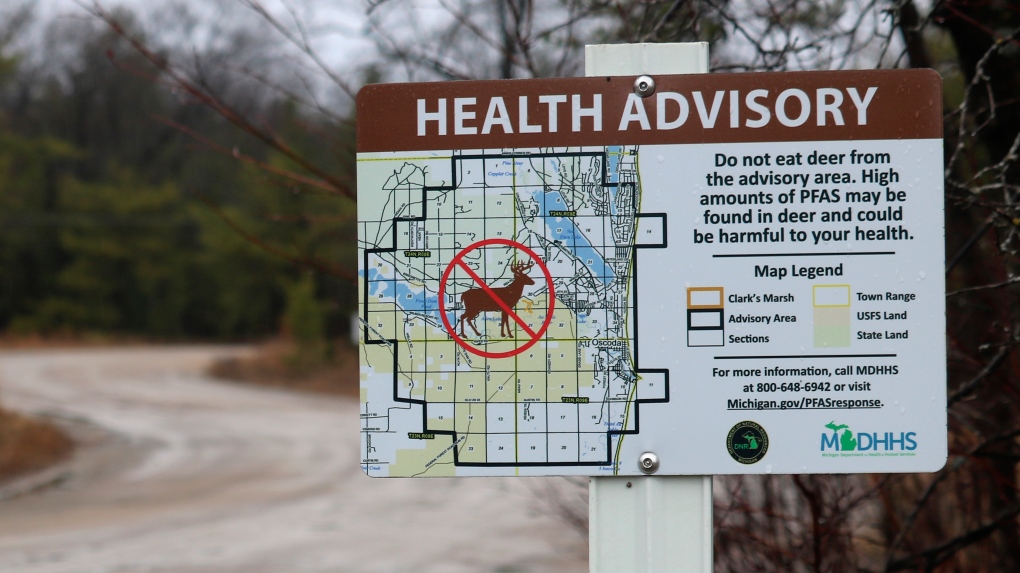
Air Canada walks back new seat selection policy change after backlash
Air Canada has paused a new seat selection fee for travellers booked on the lowest fares just days after implementing it.
Potentially toxic chemicals called PFAS (perfluoroalkyl and polyfluoroalkyl substances) are found in surface and groundwaters around the world at levels much higher than many international regulators allow, a new study found.
Called “forever chemicals” because they fail to break down fully in the environment, PFAS have been used since the 1950s to make consumer products nonstick, oil- and water-repellent and resistant to temperature change.
Even in locations with no known source of contamination, 31% of ground water samples exceeded threshold limits proposed in March 2023 by the U.S. Environmental Protection Agency, according to the study, and nearly 70% exceeded standards set by Health Canada.
The EPA proposal, soon expected to be finalized, set a specific limit of 4 parts per trillion for two older legacy chemicals, perfluorooctane sulfonic acid (PFOS) and perfluorooctanoic acid (PFOA), while also setting new limits for a mixture of four chemicals developed by industry to replace them.
Some of the most studied PFAS, such as PFOA and PFOS, have been linked to serious health problems such as cancer, obesity, thyroid disease, high cholesterol, decreased fertility, liver damage and hormone disruption, according to the EPA.
Exposure to PFAS is associated with decreased infant and fetal growth as well as decreased antibody response to vaccines in both adults and children, according to a 300-plus-page report released in July 2022 by the prestigious National Academies of Sciences, Engineering, and Medicine.
Studies are now finding the same health impacts from some of the newer PFAS versions, according to the report, which called for people at higher risk, such as pregnant women, young children and the elderly, to be tested for a subset of PFAS chemicals.
“The significance of this (new) paper is highlighting the failure of chemical policy and allowing widespread release of PFAS to the extent that they have been dispersed across the globe to contaminate water everywhere,” said David Andrews, a senior scientist for the Environmental Working Group, a consumer organization that monitors exposure to PFAS and other chemicals.
“These contaminants have been found in the Arctic, on the slopes of Mount Everest, in penguins, polar bears, whales and seals,” said Andrews, who was not involved in the new study. “These are chemicals that are just incredibly ubiquitous around the globe because of their release by manufacturers and how they have spread into the soil, air and water.”
Since most PFAS sampling done so far has been in developed countries and locations where academic researchers are concentrated, “if we were to test more broadly, we would find even more exposure,” Andrews added.
Various PFAS chemicals have been detected in the blood of 98% of Americans and can be stored for years in different organs in the body, according to the report by the National Academies of Sciences, Engineering, and Medicine.
However, drinking water may only be responsible for about 20% of exposure, with the most significant exposures coming from food, dust and other sources, Andrews said.
That’s because they have been used for decades in thousands of consumer products, including food packaging designed to prevent grease and water from soaking through food wrappers and beverage cups. The chemicals are also used to make carpeting, clothing and furniture resistant to stains, water and grease damage. Other uses include nonstick cookware, cell phones, commercial aircraft and low-emission vehicles.
 Environmental and health groups are pushing dozens of fast food companies, supermarket chains and other retail outlets to remove PFAS from their packaging (Steven Senne / AP Photo)
Environmental and health groups are pushing dozens of fast food companies, supermarket chains and other retail outlets to remove PFAS from their packaging (Steven Senne / AP Photo)
Public concern led to a commitment by manufacturers in 2008 to phase out use of PFOA and PFOS, two of the most widely used chemicals. However, “as PFOS and PFOA are phased out and replaced, people may be exposed to other PFAS,” the Agency for Toxic Substances and Disease Registry noted on its website.
In addition, health advisories issued in June 2023 by the EPA found certain PFAS chemicals are even more hazardous to human health than scientists originally thought, at levels thousands of times lower than previously believed.
The study, published Monday in the journal Nature Geoscience, collated and analyzed available data from more than 45,000 water samples gathered around the world since 2004.
“There can be quite a few sources to the environment, including fire-fighting training centres that used extensive amounts of foams to practice putting out fires (and therefore save lives), landfills, industries that have used PFAS in their products, factories that made PFAS and wastewater treatment plants (sewage treatment plants),” said lead study author Denis O’Connell, a professor in the school of civil and environmental engineering, at the University of New South Wales in Sydney, in an email.
Generally PFAS concentrations are higher in urban areas or areas that used PFAS products extensively, O’Connell said, but it is also leached into the environment in ways that may not be obvious.
“Another example is that PFAS used to be used in ski wax, so pristine environments, where people ski, have PFAS in their waters and soils,” he said.
There are more than 14,000 distinct types of PFAS, but only a few undergo routine testing in water, O’Connell said. That’s another reason the extent of the pollution and subsequent potential harm to human health may be much more extensive than currently known.
“We only know the health impacts of a few PFAS, so more work is required to determine health and ecosystem impacts of a range of PFAS,” O’Connell said.
 A sign warning hunters not to eat deer because of high amounts of toxic chemicals in their meat, in Oscoda, Mich., March 26, 2021. Wildlife agencies are finding elevated levels of PFAS chemicals in game animals, prompting new restrictions on hunting and fishing (Photo by Drew YoungeDyke, National Wildlife Federation via AP)
A sign warning hunters not to eat deer because of high amounts of toxic chemicals in their meat, in Oscoda, Mich., March 26, 2021. Wildlife agencies are finding elevated levels of PFAS chemicals in game animals, prompting new restrictions on hunting and fishing (Photo by Drew YoungeDyke, National Wildlife Federation via AP)
Many treatment plants in major cities already filter for PFAS, and with the new EPA guidelines, more will be required to do so within the next three years. However, about 15% of the U.S. population, or more than 43 million people, use well water, which is not federally regulated, according to the U.S. Geological Survey.
Anyone who is concerned about their water can purchase a test online or from a certified lab, Andrews told CNN in a prior interview.
“The most important thing is to ensure the testing method can detect down to at least four parts per trillion or lower of PFAS,” he said. “There are a large number of labs across the country certified to test to that level, so there are a lot of options available.”
If levels are concerning, consumers can purchase a water filter for their tap. NSF, formerly the National Sanitation Foundation, has a list of recommended filters.
“The water filters that are most effective for PFAS are reverse osmosis filters, which are more expensive, about in the US$200 range,” Andrews said. Reverse osmosis filters can remove a wide range of contaminants, including dissolved solids, by forcing water through various filters.
Granular activated carbon filters are more common and less expensive but not quite as effective or consistent for PFAS, he added.
“The important part is that you have to keep changing those filters,” he said. “If you don’t change that filter, and it becomes saturated, the levels of PFAS in the filtered water can actually be above the levels in the tap water.”

Air Canada has paused a new seat selection fee for travellers booked on the lowest fares just days after implementing it.
An ongoing municipal strike, court battles and revolt by half of council has prompted the province to oust the mayor and council in Black River-Matheson.
Three officers on a U.S. Marshals Task Force serving a warrant for a felon wanted for possessing a firearm were killed and five other officers were wounded in a shootout Monday at a North Carolina home, police said.
A Calgary elementary school principal has been charged with possession of child pornography, authorities announced Monday.
The Vancouver Island Health Authority is downplaying what staff describe as a cockroach infestation in a medical unit of Saanich Peninsula Hospital.
Toronto police say 12 people are facing a combined 102 charges in connection with an investigation into a major credit fraud scheme.
One of the winners of a historic US$1.3 billion Powerball jackpot last month is an immigrant from Laos who has had cancer for eight years and had his latest chemotherapy treatment last week.
Britney Spears and her father Jamie Spears will avoid what could have been a long, ugly and revealing trial with a settlement of the lingering issues in the court conservatorship that controlled her life and financial decisions for nearly 14 years.
The clock is ticking ahead of the deadline to file a 2023 income tax return. A personal finance expert explains why you should get them done -- even if you owe more than you can pay.

Since 1932, Montreal's Henri Henri has been filled to the brim with every possible kind of hat, from newsboy caps to feathered fedoras.
Police in Oak Bay, B.C., had to close a stretch of road Sunday to help an elephant seal named Emerson get safely back into the water.
Out of more than 9,000 entries from over 2,000 breweries in 50 countries, a handful of B.C. brews landed on the podium at the World Beer Cup this week.
Raneem, 10, lives with a neurological condition and liver disease and needs Cholbam, a medication, for a longer and healthier life.
The lawyer for a residential school survivor leading a proposed class-action defamation lawsuit against the Catholic Church over residential schools says the court action is a last resort.
Mounties in Nanaimo, B.C., say two late-night revellers are lucky their allegedly drunken antics weren't reported to police after security cameras captured the men trying to steal a heavy sign from a downtown business.
A property tax bill is perplexing a small townhouse community in Fergus, Ont.
When identical twin sisters Kim and Michelle Krezonoski were invited to compete against some of the world’s most elite female runners at last week’s Boston Marathon, they were in disbelief.
The giant stone statues guarding the Lions Gate Bridge have been dressed in custom Vancouver Canucks jerseys as the NHL playoffs get underway.